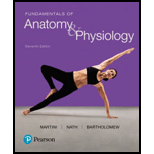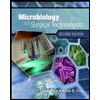
Pearson eText Fundamentals of Anatomy & Physiology -- Instant Access (Pearson+)
11th Edition
ISBN: 9780136874089
Author: Frederic Martini, Judi Nath
Publisher: PEARSON+
expand_more
expand_more
format_list_bulleted
Question
Chapter 29, Problem 26CP
Summary Introduction
To discuss:
The low sperm count (oligospermia) in Joe. The reasons how this low sperm count will interfere his ability to have children while he remembers from the biology class that it only takes one sperm to fertilize an egg.
Introduction:
The fertilization involves the fusion of male sperm and female oocyte and this process will takes place in isthmus-ampulla junction of uterine tube. The sperms are released from the spermatogenesis and oocytes are released from oogenesis.
Expert Solution & Answer
Want to see the full answer?
Check out a sample textbook solution
Students have asked these similar questions
What is the structure and function of Eukaryotic cells, including their organelles? How are Eukaryotic cells different than Prokaryotic cells, in terms of evolution which form of the cell might have came first? How do Eukaryotic cells become malignant (cancerous)?
What are the roles of DNA and proteins inside of the cell? What are the building blocks or molecular components of the DNA and proteins? How are proteins produced within the cell? What connection is there between DNA, proteins, and the cell cycle? What is the relationship between DNA, proteins, and Cancer?
Why cells go through various types of cell division and how eukaryotic cells control cell growth through the cell cycle control system?
Chapter 29 Solutions
Pearson eText Fundamentals of Anatomy & Physiology -- Instant Access (Pearson+)
Ch. 29 - Define differentiation.Ch. 29 - What event marks the onset of development?Ch. 29 - Define inheritance.Ch. 29 - Prob. 4CPCh. 29 - Prob. 5CPCh. 29 - Define gestation.Ch. 29 - Characterize the key features of each trimester.Ch. 29 - What is the developmental fate of the inner cell...Ch. 29 - Improper development of which of the...Ch. 29 - Prob. 10CP
Ch. 29 - Prob. 11CPCh. 29 - Prob. 12CPCh. 29 - Prob. 13CPCh. 29 - Prob. 14CPCh. 29 - Prob. 15CPCh. 29 - Prob. 16CPCh. 29 - Prob. 17CPCh. 29 - Prob. 18CPCh. 29 - Prob. 19CPCh. 29 - Prob. 20CPCh. 29 - What is the difference between colostrum and...Ch. 29 - Prob. 22CPCh. 29 - Describe the relationship between genotype and...Ch. 29 - Prob. 24CPCh. 29 - Prob. 25CPCh. 29 - Prob. 26CPCh. 29 - The chorionic villi (a) form the umbilical cord,...Ch. 29 - Identify the two extra-embryonic membranes and the...Ch. 29 - The hormone that is the basis for a pregnancy test...Ch. 29 - Recessive X-linked traits (a) are passed from...Ch. 29 - Prob. 5RQCh. 29 - Prob. 6RQCh. 29 - Prob. 7RQCh. 29 - If an allele must be present on both the maternal...Ch. 29 - Prob. 9RQCh. 29 - (a) What are the four extra-embryonic membranes?...Ch. 29 - Prob. 11RQCh. 29 - List the factors involved in initialing labor...Ch. 29 - Identify the three life stages that occur between...Ch. 29 - What hormonal events are responsible for puberty?...Ch. 29 - A normally pigmented woman whose father was an...Ch. 29 - Prob. 16RQCh. 29 - Prob. 17RQCh. 29 - After implantation, how does the developing embryo...Ch. 29 - Name the primary placental hormones and their...Ch. 29 - Prob. 20RQCh. 29 - During true labor, what physiological mechanisms...Ch. 29 - What physiological adjustments must an infant make...Ch. 29 - Distinguish between the following paired terms:...Ch. 29 - Indicate the type of inheritance involved in each...Ch. 29 - Hemophilia A, a condition in which blood does not...Ch. 29 - Joe and Jane desperately want to have children,...Ch. 29 - Alina has just given birth to a little girl. When...Ch. 29 - Prob. 28RQCh. 29 - Prob. 1CCCh. 29 - Are Hans and Willem monozygotic twins or dizygotic...
Knowledge Booster
Learn more about
Need a deep-dive on the concept behind this application? Look no further. Learn more about this topic, biology and related others by exploring similar questions and additional content below.Similar questions
- In one paragraph show how atoms and they're structure are related to the structure of dna and proteins. Talk about what atoms are. what they're made of, why chemical bonding is important to DNA?arrow_forwardWhat are the structure and properties of atoms and chemical bonds (especially how they relate to DNA and proteins).arrow_forwardThe Sentinel Cell: Nature’s Answer to Cancer?arrow_forward
- Molecular Biology Question You are working to characterize a novel protein in mice. Analysis shows that high levels of the primary transcript that codes for this protein are found in tissue from the brain, muscle, liver, and pancreas. However, an antibody that recognizes the C-terminal portion of the protein indicates that the protein is present in brain, muscle, and liver, but not in the pancreas. What is the most likely explanation for this result?arrow_forwardMolecular Biology Explain/discuss how “slow stop” and “quick/fast stop” mutants wereused to identify different protein involved in DNA replication in E. coli.arrow_forwardMolecular Biology Question A gene that codes for a protein was removed from a eukaryotic cell and inserted into a prokaryotic cell. Although the gene was successfully transcribed and translated, it produced a different protein than it produced in the eukaryotic cell. What is the most likely explanation?arrow_forward
- Molecular Biology LIST three characteristics of origins of replicationarrow_forwardMolecular Biology Question Please help. Thank you For E coli DNA polymerase III, give the structure and function of the b-clamp sub-complex. Describe how the structure of this sub-complex is important for it’s function.arrow_forwardMolecular Biology LIST three characteristics of DNA Polymerasesarrow_forward
arrow_back_ios
SEE MORE QUESTIONS
arrow_forward_ios
Recommended textbooks for you
 Microbiology for Surgical Technologists (MindTap ...BiologyISBN:9781111306663Author:Margaret Rodriguez, Paul PricePublisher:Cengage Learning
Microbiology for Surgical Technologists (MindTap ...BiologyISBN:9781111306663Author:Margaret Rodriguez, Paul PricePublisher:Cengage Learning Human Biology (MindTap Course List)BiologyISBN:9781305112100Author:Cecie Starr, Beverly McMillanPublisher:Cengage Learning
Human Biology (MindTap Course List)BiologyISBN:9781305112100Author:Cecie Starr, Beverly McMillanPublisher:Cengage Learning Human Heredity: Principles and Issues (MindTap Co...BiologyISBN:9781305251052Author:Michael CummingsPublisher:Cengage Learning
Human Heredity: Principles and Issues (MindTap Co...BiologyISBN:9781305251052Author:Michael CummingsPublisher:Cengage Learning Principles Of Radiographic Imaging: An Art And A ...Health & NutritionISBN:9781337711067Author:Richard R. Carlton, Arlene M. Adler, Vesna BalacPublisher:Cengage Learning
Principles Of Radiographic Imaging: An Art And A ...Health & NutritionISBN:9781337711067Author:Richard R. Carlton, Arlene M. Adler, Vesna BalacPublisher:Cengage Learning



Microbiology for Surgical Technologists (MindTap ...
Biology
ISBN:9781111306663
Author:Margaret Rodriguez, Paul Price
Publisher:Cengage Learning

Human Biology (MindTap Course List)
Biology
ISBN:9781305112100
Author:Cecie Starr, Beverly McMillan
Publisher:Cengage Learning

Human Heredity: Principles and Issues (MindTap Co...
Biology
ISBN:9781305251052
Author:Michael Cummings
Publisher:Cengage Learning

Principles Of Radiographic Imaging: An Art And A ...
Health & Nutrition
ISBN:9781337711067
Author:Richard R. Carlton, Arlene M. Adler, Vesna Balac
Publisher:Cengage Learning
The Human Reproductive System; Author: Professor Dave Explains;https://www.youtube.com/watch?v=TucxiIB76bo;License: Standard YouTube License, CC-BY